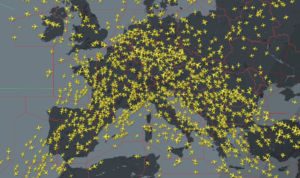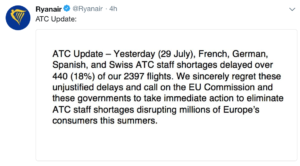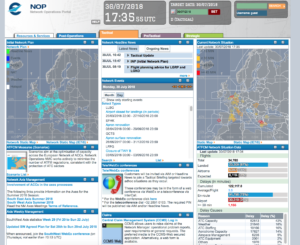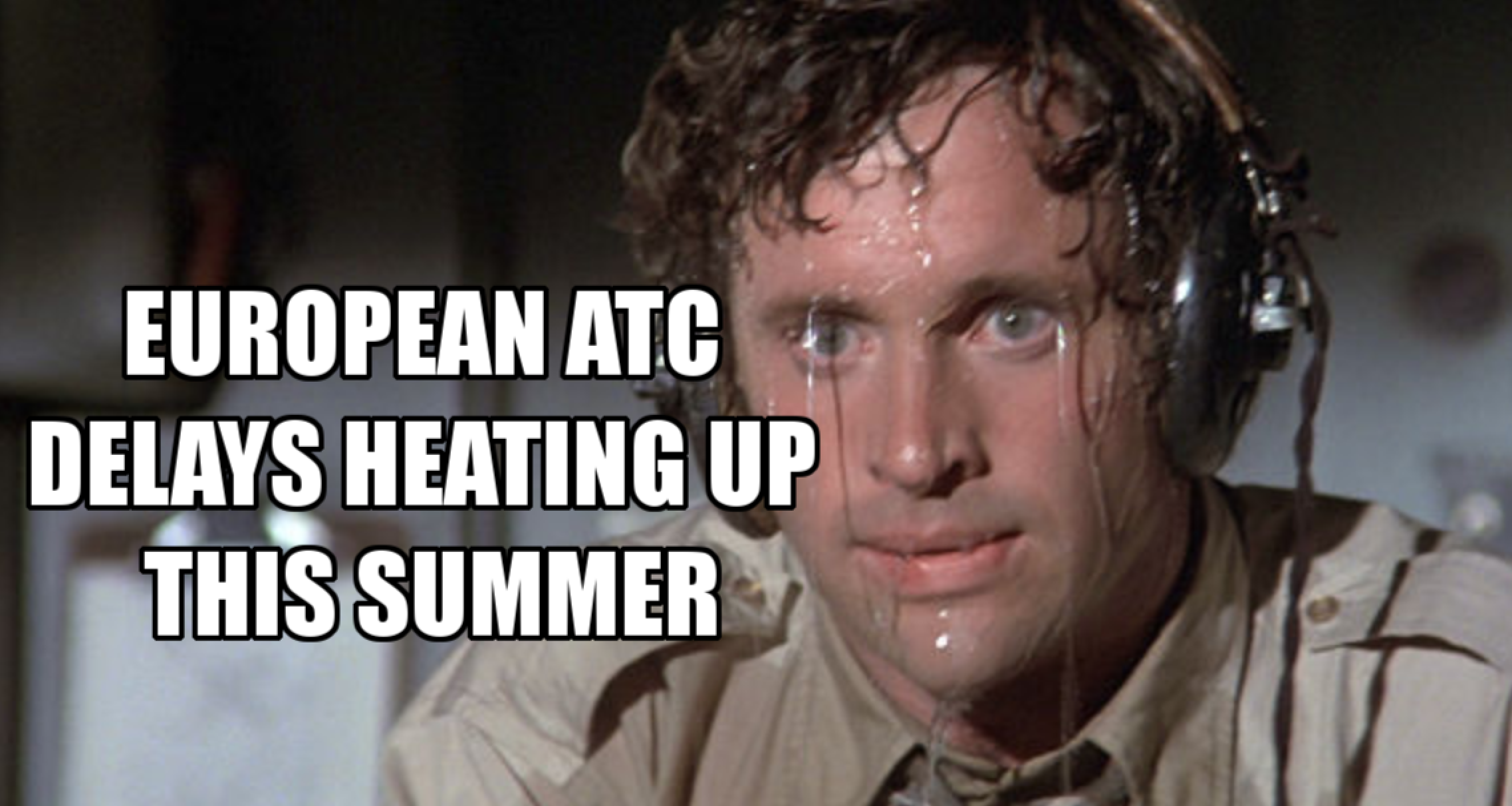In Short: European ATC delays are on the increase, caused by staffing and capacity shortages. Monitor the Network Operations Portal and be flexible in your routing options if bad weather or capacity constraints are expected.
 It’s been a great few days on a sun-soaked Mediterranean island. Your passengers are onboard, you are about to close the door, and then you get told your Calculated Take Off Time (CTOT) is an hour from now! Sound familiar? You’re not alone! ?
It’s been a great few days on a sun-soaked Mediterranean island. Your passengers are onboard, you are about to close the door, and then you get told your Calculated Take Off Time (CTOT) is an hour from now! Sound familiar? You’re not alone! ?
European air travel this summer is surging and about to hit maximum intensity. Problem is, the ATC system doesn’t seem to be coping, and the misery of long flight delays keeps getting worse.
Delays are up
IATA has recently reported the following:
“Data from Eurocontrol shows that in the first half of 2018, Air Traffic Management (ATM) delays more than doubled to 47,000 minutes per day, 133% more than in the same period last year. Most of these delays are caused by staffing and capacity shortages as well as other causes such as weather delays and disruptive events such as strikes. The average delay for flights delayed by air traffic control limitations reached 20 minutes in July, with the longest delay reaching 337 minutes.”
As an operator, you may be used to seeing alerts like these daily:
EDYY (Maastricht)
Several sectors regulated due to Airspace Management and ATC Staffing/Capacity.
Moderate to high delays.
LFMM (Marseille)
Several sectors regulated due to ATC Capacity/Staffing.
Moderate to high delays.

So is it a story of too many planes and not enough airspace (capacity) or just not enough controllers (staffing)?
Local airlines are not impressed. Ryanair took to twitter this week calling the delays “unjustified”.
In a unusually aggressive statement IATA commented that “key ANSPs in Europe have not made needed investments in their businesses, preferring instead to make super-normal profits.”
Some of the things we recommend to keep on top of expected delays
 Review the Network Operations Portal regularly – This will assist in making operational planning decisions based on the current delays and capacity restrictions. Also keep an eye on the NOC tactical briefing for the following day which may also assist.
Review the Network Operations Portal regularly – This will assist in making operational planning decisions based on the current delays and capacity restrictions. Also keep an eye on the NOC tactical briefing for the following day which may also assist.- Avoid the early morning rush of departures if you can (0900z).
- Be flexible in your routing options if bad weather or capacity constraints are expected.
- Discuss with the local FBO for latest on-ground situation to better plan arrival and departure.
- Monitor Opsgroup – members are always posting the latest information on recent airport and overflight experiences. Not yet a member? Go here!
- Subscribe to our Daily Brief to get all the latest info on ATC strikes, Airport closures, and everything else causing delays.
Got any tips or tricks on how to avoid or minimise most of these delays? Is there certain bit of airspace, airports or a time of day you’ve found that works best? Let us know!
Extra Reading:
- European Air Traffic Control Delays Loom over Summer Air Travel (IATA)
- Europe’s ATM Is Still Struggling With Capacity
- European airlines call on Brussels to prevent airspace ‘meltdown’
- Flight delays in Europe are surging this year
More on the topic:
- More: Ops to Europe: How to Get a Third Country Operator (TCO) Approval
- More: EASA Removes CZIBs: Middle East Risk Gets Harder to Read
- More: Summer Tips for Flight Planning in Europe
- More: EU Updates Lost Comms and Emergency Descent Rules
- More: Why EASA has Withdrawn Airspace Warnings for Iran and Israel
More reading:
- Latest: Crossing the Quiet South: From Australia to Argentina
- Latest: Major runway shutdowns ahead at KVNY/Van Nuys
- Latest: New FAA Airspace Warnings for Venezuela and Puerto Rico
- Safe Airspace: Risk Database
- Weekly Ops Bulletin: Subscribe
- Membership plans: Why join OPSGROUP?











 Get the famous weekly
Get the famous weekly 






Thoughts…
Since the 2008 crisis, ANSPs were under pressure to reduce route charges and operating costs(by 2% per annum). What are the main cost factors in a business like ATC? Which ones can be reduced? Operating costs are pretty constant. Oh yeah, reduce staff costs then. How? Well let’s let go of some older people to pension and stop recruitment.
In some places even in 2013, management was offering “golden handshakss” to ATCOs to leave the profession or go on a reduced worktime.
Who listened to the controllers who said that traffic will return and tht we need 2-3 years just to train new controllers? That’s right, nobody: “…there’s too many of you…” – thry said. European traffic predictions were talking about a 0.2-0.6% increase maximum. + 4 % came. Then 5%…
When the traffic picked up, some people made some calculations and figured out that we can’t even keep up with the natural outflow of people (ie. pension), let alone the need for more people due traffic increase. Recruiting started again all-over Europe, long-standing entry-requirements were dropped (max age, uni degree in some cases)… But it was(is) very hard to find the people who can at least give a shot at this job – and the training washout rate is still very high…
So here we are now. Airlines wanted much lower route charges, cheaper ATC. Now they suddenly want more capacity. Well, here’s the bad news: it doesn’t work like this. This situation will only get worse until 2021 and then maybe it’l start improving. Maybe.
Guess where are the people now, who came up with these brilliant ideas yo reduce costs by reducing vontroller staffing? That’s right, they’re already promoted… Who get the hatred of the public for the delays? The controllers.
“Since 1 January 2012, the European Commission has regulated en-route services by means of a performance scheme for air navigation services and network functions (EU Regulation 390/2013 laying down a performance scheme for air navigation services and network functions) and the introduction of a common charging scheme (EU Regulation 391/2013 laying down a common charging scheme for air navigation services).”
DFS Annual Report 2015
https://www.gdf.de/index.php/de/2-aktuelles/377-pressemitteilung-16-07-2018